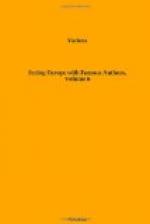We had finished breakfast. We wanted something warm, a little coffee. Schmidt set up our spirit-lamp behind two great stones that protected it from the wind. And while we waited for the water to boil, he related to us the story of Colani, the legendary hunter of the upper Engandine.
“Colani, in forty years, killed two thousand seven hundred chamois. This strange man had carved out for himself a little kingdom in the mountain. He claimed to reign there alone, to be absolute master. When a stranger penetrated into his residence, within the domain of ’his reserved hunting-ground,’ as he called the regions of the Bernina, he treated him as a poacher, and chased him with a gun....
“Colani was feared and dreaded as a diabolical and supernatural being; and indeed he took no pains to undeceive the public, for the superstitious terrors inspired by his person served to keep away all the chamois-hunters from his chamois, which he cared for and managed as a great lord cares for the deer in his forests. Round the little house which he had built for himself on the Col de Bernina, and where he passed the summer and autumn, two hundred chamois, almost tame, might be seen wandering about and browsing. Every year he killed about fifty old males.”
THE CELEBRITIES OF GENEVA[62]
BY FRANCIS H. GRIBBLE
It has been remarked as curious that the Age of Revolution at Geneva was also the Golden Age—if not of Genevan literature, which has never really had any Golden Age, at least of Genevan science, which was of world-wide renown.
The period is one in which notable names meet us at every turn. There were exiled Genevans, like de Lolme, holding their own in foreign political and intellectual circles; there were emigrant Genevan pastors holding aloft the lamps of culture and piety in many cities of England, France, Russia, Germany, and Denmark; there were Genevans, like Francois Lefort, holding the highest offices in the service of foreign rulers; and there were numbers of Genevans at Geneva of whom the cultivated grand tourist wrote in the tone of a disciple writing of his master. One can not glance at the history of the period without lighting upon names of note in almost all departments of endeavor. The period is that of de Saussure, Bourrit, the de Lucs, the two Hubers, great authorities respectively on bees and birds; Le Sage, who was one of Gibbon’s rivals for the heart of Mademoiselle Suzanne Curchod; Senebier, the librarian who wrote the first literary history of Geneva; St. Ours and Arlaud, the painters; Charles Bonnet, the entomologist; Berenger and Picot, the historians; Tronchin, the physician; Trembley and Jallabert, the mathematicians; Dentan, minister and Alpine explorer; Pictet, the editor of the “Bibliotheque Universelle,” still the leading Swiss literary review; and Odier, who taught Geneva the virtue of vaccination.




